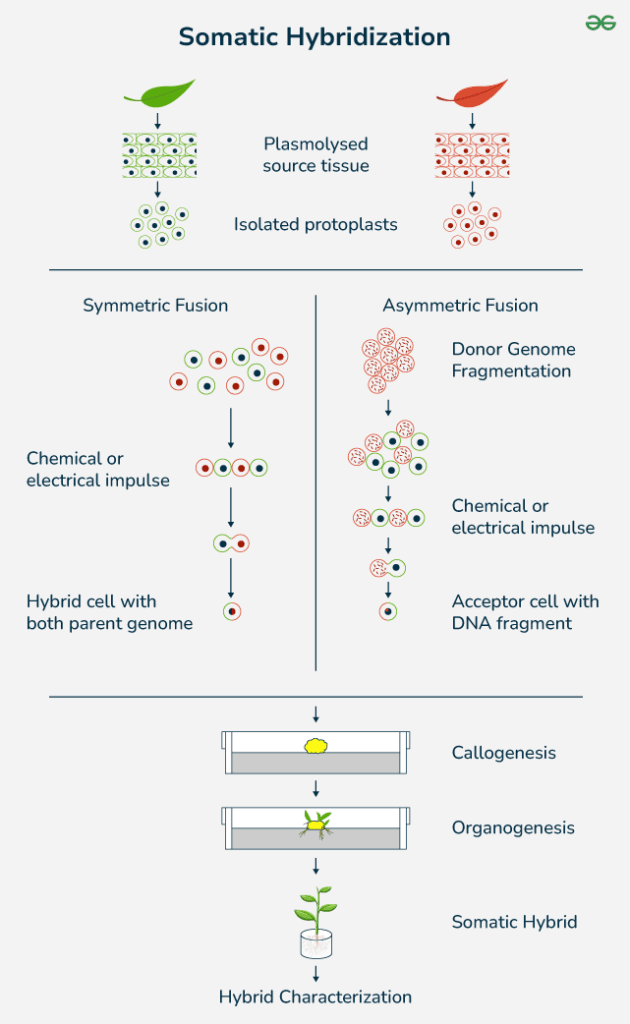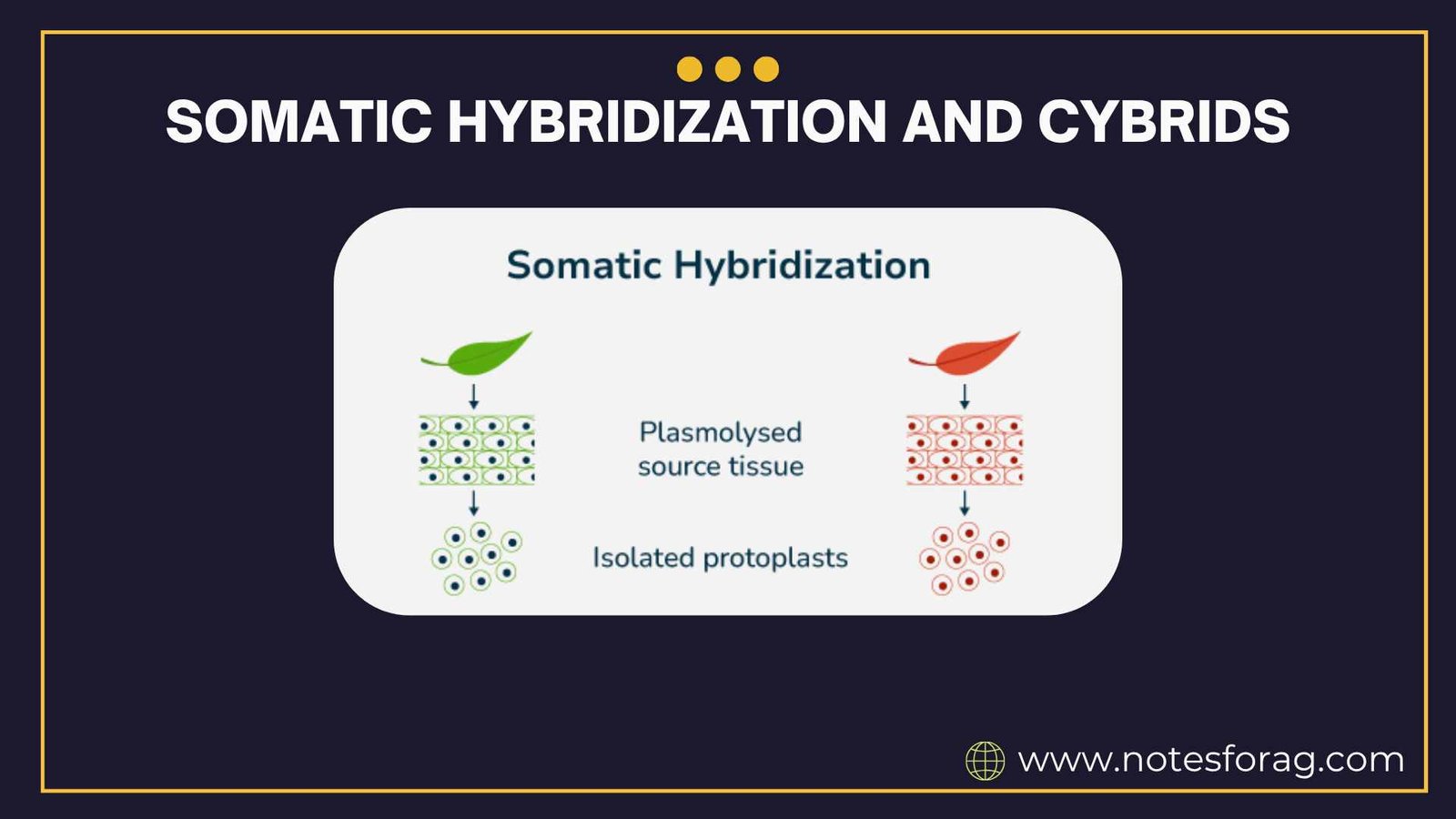Somatic hybridization and cybrid production are advanced techniques in plant biotechnology. They help in combining the genetic material of different plant species, creating new plant varieties that are difficult to produce through traditional breeding. These methods are essential for crop improvement, disease resistance, and developing plants with unique traits.
Somatic Hybridization: Process, Advantages, and Limitations

What is Somatic Hybridization?
Somatic hybridization is a plant breeding technique where two different plant cells without cell walls (protoplasts) are fused to form a single cell. This fused cell grows into a hybrid plant that carries genetic material from both parent plants.
Table of Contents
Process of Somatic Hybridization
Protoplast Isolation
The process begins with the isolation of protoplasts. Plant tissues are treated with enzymes like cellulase and pectinase to remove cell walls, leaving naked cells called protoplasts.
Protoplast Fusion
The isolated protoplasts from two different plants are fused using chemical agents like polyethylene glycol (PEG) or by applying an electric current. This fusion combines the genetic material of both cells.
Selection of Hybrid Cells
After fusion, not all cells will be hybrids. Special culture media and selection markers are used to identify and select the successfully fused hybrid cells.
Regeneration of Hybrid Plants

The selected hybrid cells are cultured in nutrient-rich media to develop callus tissue, which is then induced to form shoots and roots. These develop into complete hybrid plants.
Advantages of Somatic Hybridization
- Combines desirable traits from different species.
- Overcomes barriers of sexual incompatibility.
- Useful for transferring disease resistance.
Limitations of Somatic Hybridization
- Low efficiency of protoplast fusion.
- Difficulties in plant regeneration.
- Possible genetic instability.
Applications of Somatic Hybridization
Crop Improvement
Somatic hybridization helps in creating new plant varieties with enhanced yield, improved quality, and better stress tolerance.
Disease Resistance
The technique is used to transfer resistance genes from wild species to cultivated crops, making plants resistant to diseases and pests.
Overcoming Breeding Barriers
Some plants cannot be crossed through traditional methods due to genetic incompatibility. Somatic hybridization bypasses these barriers.
Production of Novel Plants
Somatic hybrids often exhibit unique characteristics not found in either parent, leading to the creation of entirely new plant types.
Example Applications
- Citrus species: Somatic hybrids are used to produce disease-resistant citrus plants.
- Potato breeding: Fusion of cultivated and wild potato species to develop resistant varieties.
Cybrids: Concept, Formation, and Importance
What are Cybrids?

Cybrids, or cytoplasmic hybrids, are plant cells that contain the nuclear genome from one parent and the cytoplasmic organelles (mitochondria and chloroplasts) from both or just one of the parents.
Formation of Cybrids
Protoplast Fusion for Cybrid Production
Cybrids are formed by fusing a normal protoplast with an enucleated protoplast (a cell that has had its nucleus removed). This way, the resulting cell has the nucleus from one parent but cytoplasmic elements from both.
Selection and Regeneration
After fusion, the cybrid cells are selected and cultured to regenerate into complete plants with the desired nuclear and cytoplasmic genetic combination.
Importance of Cybrids
- Allows transfer of cytoplasmic traits, such as male sterility.
- Useful in developing plants with specific mitochondrial or chloroplast characteristics.
Applications of Cybrids
Male Sterility Induction
Cybrids are used to develop male-sterile lines, which are essential for hybrid seed production.
Cytoplasmic Trait Transfer
Through cybridization, beneficial traits located in mitochondria or chloroplasts can be introduced into new plant lines.
Improving Crop Quality
Cybrids can be used to introduce specific cytoplasmic factors that improve plant vigor, quality, or resistance to certain stresses.
Example Applications
- Brassica crops: Cybrids have been used to transfer cytoplasmic male sterility for hybrid production.
- Citrus breeding: Used to combine desirable cytoplasmic traits for disease resistance and improved growth.
Techniques in Somatic Hybridization and Cybrid Production
Protoplast Isolation Techniques
Protoplasts are isolated by enzymatic digestion using cellulase and pectinase, which remove plant cell walls without damaging the inner cell structures.
Protoplast Fusion Techniques
Chemical Fusion
Involves using polyethylene glycol (PEG) to induce cell fusion.
Electrical Fusion
Uses electric fields to align and fuse protoplasts.
Selection Techniques
Selective culture media, antibiotics, and genetic markers are used to identify hybrid and cybrid cells from the mixture.
Regeneration Techniques
Regeneration involves the culture of protoplast-derived cells to form callus, followed by organogenesis or somatic embryogenesis to produce whole plants.
Challenges in Somatic Hybridization and Cybrid Production
Technical Challenges
- Low frequency of successful fusion.
- Difficulty in regenerating whole plants from fused protoplasts.
Genetic Challenges
- Instability and unexpected genetic combinations.
- Difficulty in predicting which traits will be expressed.
Selection Challenges
- Selecting true hybrids and cybrids from the fused cell population can be complex and time-consuming.
Commercial Challenges
- High cost of laboratory setup and skilled labor.
- Limited success in some plant species.
Future Prospects
Advancements in Technology
Improvements in cell fusion methods, protoplast culture, and selection techniques are expected to make somatic hybridization and cybrid production more efficient.
Genetic Engineering Integration
Combining these techniques with modern genetic engineering and genome editing tools like CRISPR may enhance their potential.
Expanding to New Species
Ongoing research aims to apply somatic hybridization and cybrid production to a wider range of plants, including important food crops.
Sustainable Agriculture
These technologies can contribute to developing resilient plant varieties that support sustainable and climate-smart agriculture.
Conclusion
Somatic hybridization and cybrid production are powerful tools in plant biotechnology. They allow scientists to create new plant varieties by combining desirable traits from different species and transferring specific cytoplasmic factors. These techniques offer solutions to traditional breeding barriers and help improve crop resistance, yield, and quality.
Although there are challenges in efficiency, selection, and plant regeneration, the future of these methods looks promising with ongoing advancements in technology and genetic research. As plant breeders and scientists continue to refine these processes, somatic hybridization and cybrid production will play a vital role in sustainable agriculture, food security, and the conservation of valuable plant genetic resources.
Frequently Asked Questions (FAQs)
What is somatic hybridization in plants?
Somatic hybridization is a laboratory technique that fuses two plant cells without cell walls (protoplasts) to create a hybrid cell. This cell is then regenerated into a plant merging traits from both parents, allowing breeders to overcome species barriers.
What are key applications of somatic hybridization?
This technique helps in:
Producing disease- or pest-resistant plants by combining traits from wild and cultivated varieties
Introducing traits such as stress tolerance or improved yield into crops
Creating novel plants that cannot be developed through conventional breeding.
How are cybrids different from somatic hybrids?
A cybrid (cytoplasmic hybrid) is created by fusing a normal cell with one that has no nucleus (a cytoplast). The result carries the nucleus from one parent and cytoplasmic organelles (like mitochondria or chloroplasts) from both, enabling transfer of cytoplasmic traits.
Related Articles

